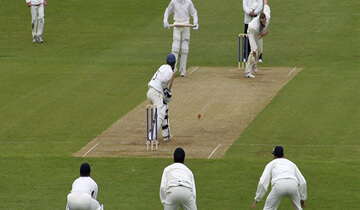In cricket tournaments with a group stage, net run rate (NRR) is an important statistic used to separate teams who finish with equal points. NRR measures a team’s runs per over across all matches, taking into account balls faced and wickets lost. It provides a means of ranking teams based on overall batting and bowling performances, beyond just wins and losses. With playoff qualifications and seedings often coming down to decimal points in NRR, its calculation and optimization throughout a tournament can be crucial. This was evidenced recently during the group stage of the 2021 ICC T20 World Cup, when net run rates became a major discussion point as several teams battled for positions in the semi-finals. This article will take a deeper look at how NRR is calculated, why it is necessary, how teams can improve their net run rate, and examine specific examples of its significant impact.
How to Calculate Net Run Rate (NRR) in Cricket
Calculate the Batting Run Rate
First, calculate the batting run rate by taking the total runs scored by the team and dividing it by the total overs faced. If the team was all out before their allotted overs were completed, use the maximum overs allotted instead of the actual overs faced.
For example, if a team scored 250 runs in 40 overs (before being all out), their batting run rate would be 250/50 = 5 runs per over (as 50 overs is the maximum in an ODI match).
Calculate the Bowling Run Rate
Next, calculate the bowling run rate by taking the total runs conceded and dividing it by the total overs bowled. If the opposition team was all out before the full overs were bowled, use the maximum over allotment instead of actual overs bowled.
For example, if a team conceded 300 runs in 45 overs before bowling the opposition out, their bowling run rate would be 300/50 = 6 runs per over.
Calculate the Net Run Rate
Finally, subtract the bowling run rate from the batting run rate to calculate the net run rate.
In our example, the NRR would be:
Batting Run Rate: 5 runs per over
Bowling Run Rate: 6 runs per over
Net Run Rate = 5 - 6 = -1
A positive NRR is better for rankings, indicating a team has scored runs faster than it has conceded them. NRR gives a good overall impression of the team’s performances and is a crucial metric in league tournaments like the IPL.
Calculating Net Run Rate in Cricket: A Step-by-Step Example
Net run rate (NRR) is an important statistic in cricket that is used to separate teams with equal points in league tables. It measures a team’s runs per over across all matches, providing a gauge of how quickly and efficiently a team scores runs. Calculating NRR can seem complicated at first, but following a match example makes it clearer.
Walking Through a Sample Match
Let’s look at a fictional match between Team A and Team B to see how NRR is determined:
In the first innings, Team A scores 250 runs in 50 overs (300 balls). Their run rate is 250/50 = 5 runs per over.
In the second innings, Team B is bowled out for 200 runs in 40 overs (240 balls). Their run rate is 200/40 = 5 runs per over.
Team A won the match by 50 runs. But to calculate NRR, we need to look at the run rates.
Calculating NRR for Each Team
Team A scored 5 runs per over across 50 overs. So their NRR for this match is +5.
Team B scored 5 runs per over across 40 overs. As they batted 10 overs less than Team A, their NRR is calculated as:
Runs scored / Overs faced x 50
Therefore, Team B’s NRR is: 200/40 x 50 = 250/40 = +5
So in this match, both teams ended up with the same NRR of +5. This NRR for the single match is then added to their overall NRR across all matches.
The crucial point is that NRR accounts for the number of overs batted. This means a team that scores quickly but gets bowled out earlier can have a lower NRR than a team that scores steadily across more overs.
Why NRR Matters
Calculating NRR helps provide a fair comparison of teams’ performances across different matches. While it may seem complicated, following examples like this makes it easier to understand.
NRR Adjustment Rules for Abandoned, Forfeited or Shortened Matches
Abandoned Matches
If a match gets abandoned due to weather or other reasons before it has reached the minimum number of overs required to constitute a playable match, it is declared a “no result.” In such a case, no NRR adjustments are made and the points table remains unchanged.
However, if the match has reached the minimum overs mark but ends up getting abandoned, then certain NRR adjustments are made. For an ODI, if at least 20 overs have been bowled to the side batting second, then the match is included for NRR calculations. For T20Is, at least 5 overs need to be bowled to the team batting second.
In such cases, the target score for the team batting second is calculated using the Duckworth-Lewis-Stern (DLS) method. Their runs scored and overs faced until abandonment are measured against the DLS target to calculate their NRR adjustment. The team bowling does not get any NRR adjustment.
Forfeited Matches
If a team forfeits a match for any reason, their NRR takes a hit while the opposition benefits. The forfeiting team is deemed to have scored 0 runs in their allotted overs. So their NRR = Runs scored (0) divided by Overs allotted.
The team winning by forfeit is credited with the maximum runs they could have scored in their allotted overs at an assumed run rate of 6 runs per over. So their NRR = Projected maximum runs by forfeiting team divided by Overs allotted.
Shortened Matches
In shortened matches, where full 50 or 20 overs are not bowled, run rates are still calculated by runs scored divided by overs faced. So teams are encouraged to score faster than usual in such scenarios.
The DLS method is applied if the match has reached the minimum overs mark but is shortened due to weather or other delays. DLS is used to set a revised target for the team batting second based on overs lost, which then impacts the NRR adjustment.
So in summary, NRR calculation rules are adjusted by the ICC depending on whether matches are abandoned, forfeited or shortened, to ensure teams are neither benefitted nor disadvantaged by curtailed matches when it comes to the NRR tie-breaker.
Conclusion
In conclusion, net run rate is a crucial statistic in cricket tournaments with a group stage, used to separate teams who finish equal on points. NRR measures a team’s batting and bowling performance across all matches. The calculation involves determining batting run rate, bowling run rate, and taking the difference to get the net run rate. Positive NRR is favorable. Special rules govern NRR adjustments when matches are abandoned, forfeited or shortened. Overall, NRR provides a fair comparison of a team’s efficiency at scoring and conceding runs. Considering its potential tie-breaking impact, teams strategize to optimize their net run rate through the course of a tournament.







































